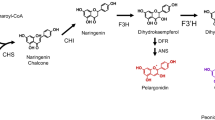Abstract
Repetitive gametic selection for a higher frequency of the Adh1-Ssemilethal mutant allele of the alcohol dehydrogenase (ADH) gene yielded viable homozygotes Adh1-SS. The plants varied in phenotype from weak mutant to nearly normal (restored). Phenotypically different plants were individually tested for combining ability. This parameter was high in plants with the mutant phenotype and tended to decrease, rather than further increase, in plants with a restored normal phenotype. The results are discussed in terms of viability restoration mechanisms in homozygotes for semilethal mutant alleles.
Similar content being viewed by others
REFERENCES
Konovalov, A.A., Selection for Allelic Variants of Alcohol Dehydrogenase in Inbred and Dihybrid Sugar Beet Progeny, Genetika (Moscow), 1994, vol. 30, no. 7, pp. 945-950.
Konovalov, A.A., Combining Ability in Sugar Beet Inbreds after Male Gametophyte Selection, Hereditas (Lund, Swed.), 1997, vol. 126, no. 2, pp. 173-177.
Konovalov, A.A., Generation and Combining Ability of Viable Homozygous Mutants for the Adh1 Locus in Sugar Beet, Genetika (Moscow), 2000, vol. 36, no. 10, pp. 1380-1387.
Rieger, R. and Michaelis, A., Genetisches und cytogenetisches Worterbuch, Berlin: Springer-Verlag, 1958.
Grineva, G.M., Regulyatsiya metabolizma u rastenii pri nedostatke kisloroda (Regulation of Plant Metabolism in Oxygen Deficiency), Moscow: Nauka, 1975.
Strunnikov, V.A., A New Hypothesis of Heterosis: Its Theoretical and Applied Significance, Vestn. S-kh. Nauki, 1983, no. 1, pp. 34-40.
Strunnikov, V.A., Priroda geterozisa i novye metody ego povysheniya (The Nature and New Methods of the Enhancement of Heterosis), Moscow: Nauka, 1994.
Vershinin, A.V., On the Nature of Genes Forming the Effect of Heterosis Based on a Chlorophyll Mutation in Pea and a Possible Mechanism of This Effect, in Strukturno-funktsional'naya organizatsiya genoma eukariot (Structural and Functional Organization of the Eukaryotic Genome), Novosibirsk: Inst. Cytol. Genet., Siberian Div., USSR Acad. Sci., 1979, pp. 5-16.
Gostimskii, S.A., Rybtsov, S.A., and Ezhova, T.A., On the Possibility of Generating Heterotic Forms on the Basis of Semilethal Chlorophyll Mutations in Pea, S-kh. Biol., 1992, no. 1, pp. 64-71.
Kornienko, A.V. and Orlov, S.D., Metody selektsii sakharnoi svekly na geterozis (Methods of Breeding for Heterosis in Sugar Beet), Moscow: Rodnik, 1996.
Gustafsson, A., Nybom, N., and von Wettstein, D., Chlorophyll Factors and Heterosis in Barley, Hereditas (Lund, Swed.), 1950, vol. 36, pp. 383-392.
Belyaev, D.K., Evsikov, V.I., and Shumnyi, V.K., Genetic and Breeding Aspects of the Problem of Monohybrid Heterosis, Genetika (Moscow), 1968, vol. 4, no. 12, pp. 46-62.
Shumnyi, V.K., Belova, L.I., and Sharova, L.A., Study of Cases of Monohybrid Heterosis in Pea, Genetika (Moscow), 1971, vol. 7, no. 9, pp. 36-41.
Shumnyi, V.K., Sidorova, K.K., and Belova, L.I., Study of the Heterozygosity for Nine Mutant Genes in Pea, Genetika (Moscow), 1970, vol. 6, no. 8, pp. 12-19.
Sidorova, K.K., Effect of Homozygosity and Heterozygosity for Various Types of Mutations on the Development of Organisms (Exemplified by Pisum sativum L. Mutants), Genetika (Moscow), 1975, vol. 11, no. 1, pp. 35-46.
Sokolov, V.A., Study of the Mechanisms of Heterosis, Doctoral (Biol.) Dissertation, Novosibirsk, 1992.
Ashby, E., Studies on the Inheritance of Physiological Characters: 1. A Physiological Investigation of the Nature of Hybrid Vigor in Maize, Ann. Bot., 1930, vol. 44, pp. 457-469.
Ashby, E., Studies on the Inheritance of Physiological Characters: 2. Further Experiments upon the Basis of Hybrid Vigor and Upon the Inheritance of Efficiency Index and Respiration Rate in Maize, Ann. Bot., 1932, vol. 46, pp. 1007-1032.
Shakhbazov, V.G., Cheshko, V.F., and Shereshevskaya, Ts.M., Mekhanizmy geterozisa: istoriya i sovremennoe sostoyanie problemy (Mechanisms of Heterosis: History and Present State of the Problem), Kharkov: Osnova, 1990.
Yamada, M., Heterosis in Embryo of Maize, Zea mays L., Bull. Nat. Inst. Agrobiol. Resour., 1985, no. 1, pp. 85-98.
Yamada, M., Ishige, T., and Ohkawa, Y., Reappraisal of Ashby's Hypothesis on Heterosis of Physiological Traits in Maize, Zea mays L., Euphytica, 1985, vol. 34, no. 3, pp. 593-598.
Rybtsov, S.A., Ezhova, T.A., and Gostimskii, S.A., Use of In Vitro Tissue Culture to Study Heterosis in the Pea, Genetika (Moscow), 1997, vol. 33, no. 11, pp. 1517-1522.
Mokan, G.S. and Roik, N.V., Physical Characters of Seeds in Breeding, Sakharn. Svekla, 1983, no. 12, p. 22.
Mazlumov, A.L., Selektsiya sakharnoi svekly (Breeding in Sugar Beet), Moscow: Kolos, 1970.
Author information
Authors and Affiliations
Rights and permissions
About this article
Cite this article
Konovalov, A.A. Phenotype Dependence of the Combining Ability in Mutant Sugar Beet. Russian Journal of Genetics 37, 150–155 (2001). https://doi.org/10.1023/A:1009037821277
Issue Date:
DOI: https://doi.org/10.1023/A:1009037821277




